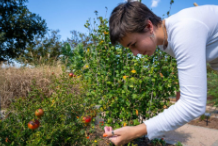Crop rotation is the recommended practice of changing the location of plants within the same family each growing season. Plants within the same family are often susceptible to similar pests. They also have similar nutrient requirements. By planting crop families in different areas of the garden each season, a common host plant is removed. Pests that overwinter in the soil or debris are not able to continue their life cycle which prevents the population from growing exponentially. Additionally, the varied root system depths and nutrient requirements prevents nutrient depletion in the soil. Often, cabbage, peas, lettuce, onions and other cool-season crops have more shallow roots. Warm-season crops tend to have a more extensive root system.
To plan your crop rotation draw a diagram of your vegetable garden now while you remember where everything is. Next year, as you making your planting plan, reference this sketch and alternate locations for each plant family. For example, in the area where you have tomatoes this year avoid planting anything from the Solanacaeae family (eggplant, pepper, potato) next year. If you planted bush beans this year, be sure to avoid planting anything from the fabaceae family (lima beans, peas, pole beans, etc.) in the same location next year.
Cynthia Domenghini, Extension Agent




